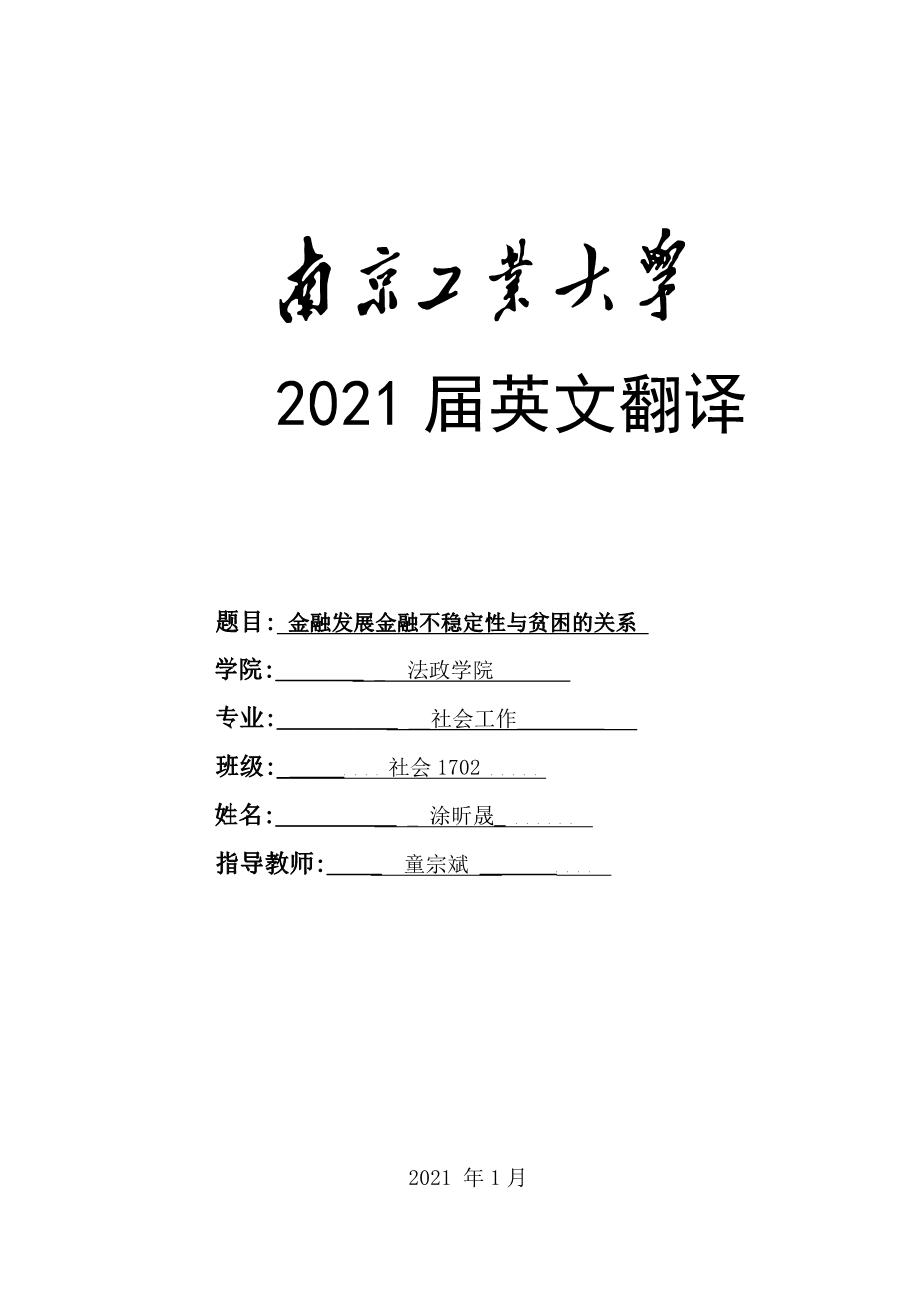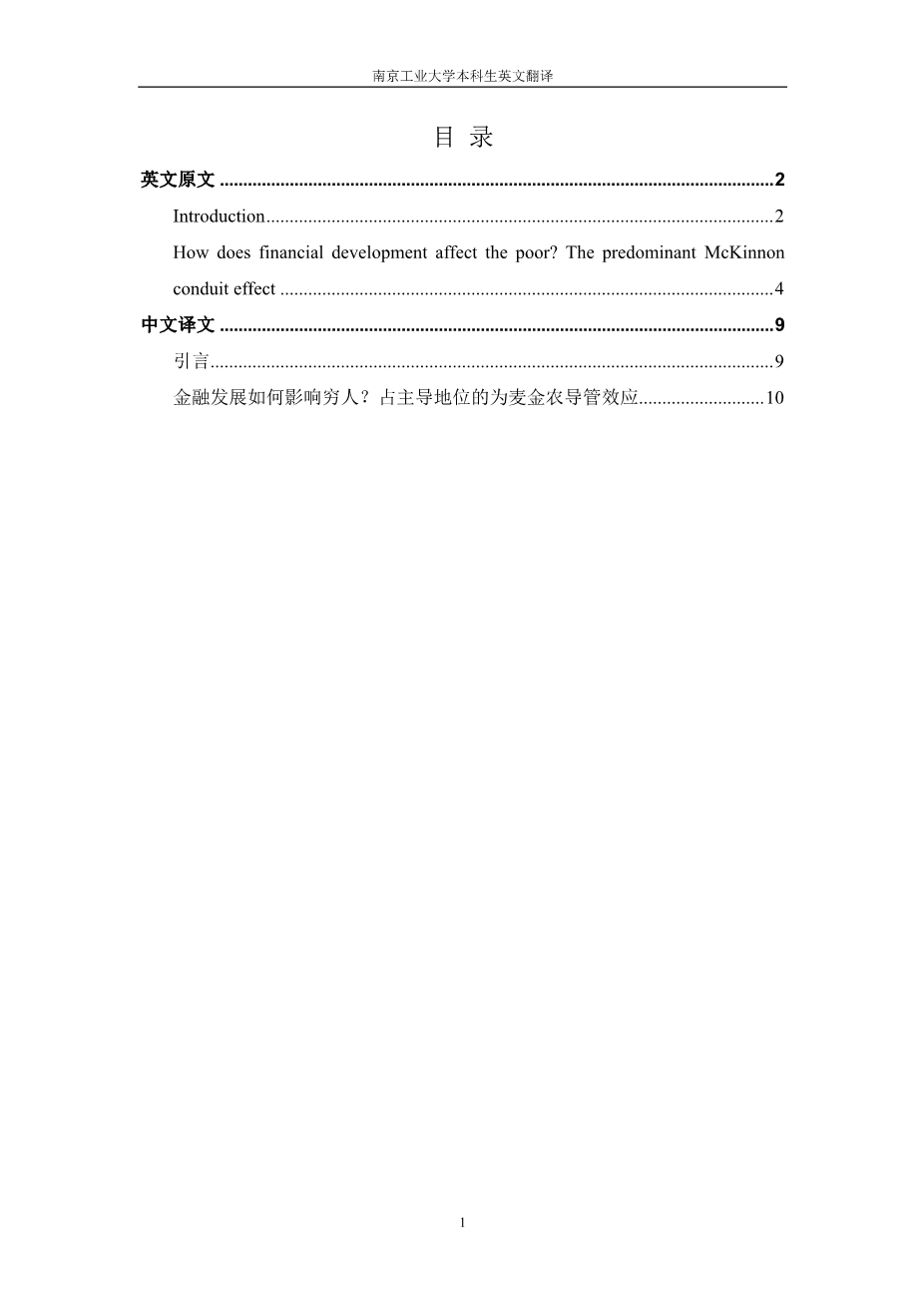

英语原文共 14 页,剩余内容已隐藏,支付完成后下载完整资料
2021届英文翻译
题目: 金融发展金融不稳定性与贫困的关系
学院:________ _ 法政学院
专业:___________ __社会工作________
班级:______ 社会1702
姓名:___________ _ 涂昕晟_
指导教师:_____ 童宗斌 _______
2021 年1月
目 录
How does financial development affect the poor? The predominant McKinnon conduit effect 4
英文原文
Financial Development, Financial Instability and Poverty(节选)
Introduction
Many studies in the past and in recent years concern the relationship between financial development and growth1 (Roubini and Sala-i-Martin, 1992; King and Levine, 1993; Easterly, 1993; Pagano, 1993; Gertler and Rose, 1994; Levine, 1997; Levine, Loayza and Beck, 2000; Khan and Senhadji, 2003; Chistopoulos and Tsionas, 2004). But until now the question of whether financial development contributes to reducing poverty has been the subject of little empirical work in economic literature (some exceptions are Dollar and Kraay (2002), Honohan (2004) and Beck, Demirguuml;ccedil;-Kunt and Levine (2004).
Evidently the impact of financial development on economic growth and its impact on the reduction of poverty are related issues, as growth is a powerful way to reduce poverty (Bruno, Ravaillon and Squire, 1998). However, it is possible that in certain countries the benefit of growth for the poor is undermined or even offset by the increases in inequality which may accompany growth. As Kanbur (2001)2 underlined, there are many empirical demonstrations that growth in real national per capita income is correlated across countries and over time with reductions in the measure of income poverty on a national level, but “the real dispute is about consequences of alternative politics”. This is why we focus here on the specific impact of financial development on poverty.
We adopt a macroeconomic approach. As Ravallion (2001)3 has underlined, “there is a need of deep microeconomic work on growth and distributional change” in order to define better the more pro-poor policies. In the field of finance, there are already many microeconomic studies concerning the need for specific institutions for the poor, such as microfinance institutions. But to understand better “the large differences between countries in how much poor people share in growth”, macroeconomic analyses are still useful as they may indicate the most pro-poor growth-oriented policies from a comparative perspective, even if econometric cross-sectional analysis faces several limitations.
As in the existing literature, we try to distinguish the indirect effect of financial development on poverty reduction through its positive action on growth from its direct impact. However, two features of our analysis set it apart from the existing literature. First, we are interested by
the channels (credit or money) through which poor people benefit from formal financial intermediation. Therefore we focus on the motive of finance for money demand suggested by Keynes (1937) and rehabilitated by McKinnon in 1973 when he presented the “conduit effect”. According to this assumption, even if financial institutions do not provide credit to poor people confined to self-financed investment, they are useful to them in so far as they offer some profitable financial opportunities for their savings. Consequently we do not only focus on a credit indicator as in Dollar and Kraay (2002), Honohan (2004) and Beck et al. (2004), but we also examine the impact of a liquidity indicator. Second, we consider that financial development is accompanied by crises; these are likely to undermine the potential benefits of financial growth, in particular for the poorest. Therefore, besides the indicator of financial development in the regression explaining poverty, we introduce an indicator of financial instability in order to reconcile the apparent contradiction between two schools of thought in the literature, the first underlining the positive effect of financial development on growth while the second shows that credit growth is one of the predictors of banking and currency crises (Loayza and Ranciere, 2002).4
We mainly adopt Dollar and Kraayrsquo;s model specification where aggregate poverty is measured by the average per capita income of the poorest population and depends on the level of real GDP per capita and other variables, which in our case integrates financial development and instability indicators. We estimate our model on as large a sample of developing countries as possible over the period 1966-2000. We use panel data and System GMM estimator in order to control for the heterogeneity of countries and the potentialendogeneity of the explanatory variables. In addition, following Honohan (2004), we estimate a second model where poverty is measured by the share of the population earning less than one dollar per day. Despite the small size of the sample, this estimation is done in order to check the robustness of our results. We cannot refute the null hypothesis that financial development is on average good for the poor while the financial instability accompanying financial development is detrimental to them. This result only holds when financial development is measured by the ratio of money to GDP and not by a credit ratio; this may be interpreted as evidence of the relevance of the conduit effect assumption.
The paper is organised as follows. Section two presents the theoretical
剩余内容已隐藏,支付完成后下载完整资料
资料编号:[267213],资料为PDF文档或Word文档,PDF文档可免费转换为Word


